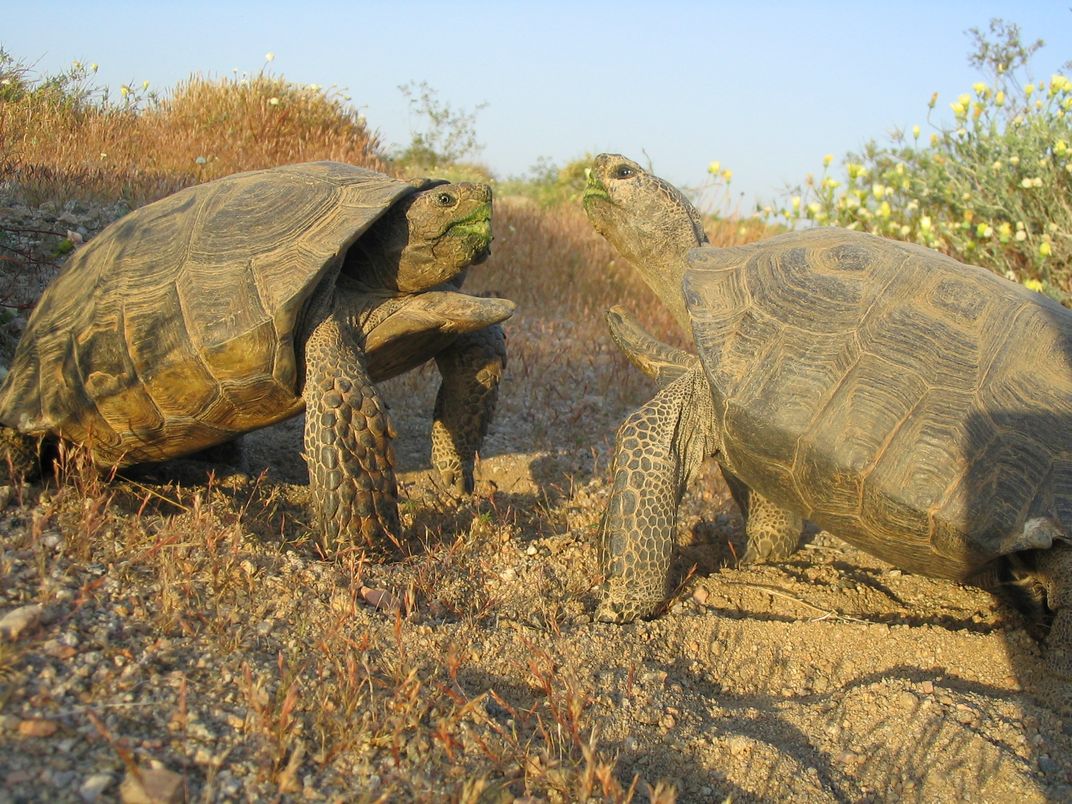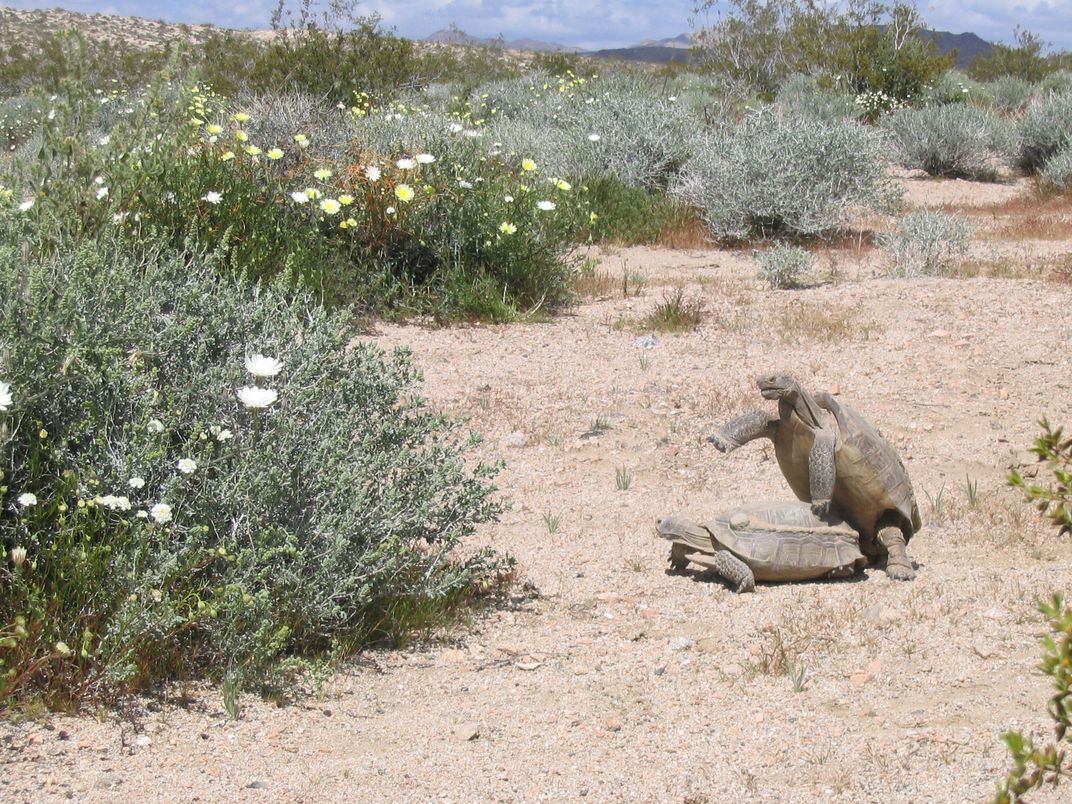Safer Digs for Tortoises Put a Damper on Their Love Lives
A new genetic study surprised scientists who learned the males were not breeding
:focal(555x156:556x157)/https://tf-cmsv2-smithsonianmag-media.s3.amazonaws.com/filer/b7/5c/b75c27ac-7a0c-40c1-b35e-eac170e1f128/tort_mating2.jpg)
In April, U.S. Marines in California completed a mission years in the making. In order to establish a new training center, they arranged for biologists to carefully transfer 1,100-some desert tortoises, a threatened species, from one area to another.
While it may have been a peculiar project for the marines, the method—known as translocation—has previously been undertaken to mitigate the effect of solar energy farms and other developments on tortoises throughout the region. And it’s a common practice for the preservation of other species as well. On the surface, such translocations constitute a valuable effort to protect animals facing habitat loss or other dangers. Now, however, newly published research suggests that the technique may not be as effective as some have assumed, at least where the tortoises are concerned.
After a translocation effort—whatever the species involved—researchers normally evaluate a handful of important indicators: Are the animals healthy? Are they finding food and establishing home ranges? Are they reproducing? In some species, however, that last question begets another, one that has rarely been studied in any depth: Are males and females reproducing at the same rates? If not, even a successful move may be disrupting a species in otherwise unnoticed ways.
In 2012, a group of researchers—including Kevin P. Mulder and Robert C. Fleischer of the Smithsonian Conservation Biology Institutes’ Center for Conservation Genomics—set out to do just that. As they explain in a paper about their work published recently in the journal Biological Conservation, their sample population was another group of Agassiz’s desert tortoises that had been moved four years before from one area near Fort Irwin in California to another.
While translocation efforts sometimes shift animals into areas uninhabited by others of their own kind, there were already established “resident” tortoises living in the new region. The researchers could see that both the translocated and resident females were laying eggs, but it wasn’t immediately clear whether the two populations were mingling.

To find out, they undertook a form of analysis known as microsatellite genotyping, a technique that’s also used in human paternity testing and forensics. As Fleischer told me, microsatellites are “highly variable” genetic sites in an organism’s genetic code. “Every individual is going to have their own DNA fingerprint if you look at more than a few of these markers combined. They’re so variable that virtually every individual that we sampled would have a different genotype across the 16 markers that we used,” Fleischer said.
To determine who had fathered the 92 tortoise hatchlings, the researchers used a process of elimination. They had gathered genetic data for most of the translocated males, but just a third of the resident males. Using that data, they found that 35 of the hatchlings had resident tortoise fathers. They couldn’t find a match for the remaining 57—which meant it was most likely they were also fathered by resident tortoises, just ones that hadn't had their genetics scanned.
In other words, while the translocated female tortoises seemed to be reproductively healthy, the translocated males were having no luck at all.
/https://tf-cmsv2-smithsonianmag-media.s3.amazonaws.com/filer/c2/d1/c2d1ad61-6fb4-4620-9c61-b91039824b1d/unmkdmale.jpg)
It’s hard to say why the translocated males have seemingly been excluded from the breeding pool. “These males were still alive and living around the females, they just apparently weren’t getting any of the matings, or the matings weren’t working,” Fleischer says. Apart from a very slightly smaller average size, however, there was relatively little to distinguish them from the residents. The paper’s authors suggest that it might have something to do with dominance hierarchies among the members of the species. They also speculate that the females’ apparent capacity for sperm storage and selection may play a role.
Whatever the reason, one of the paper’s co-authors, research ecologist Andrew Walde told me these results were “absolutely shocking.” Without genetic analysis, it’s the sort of thing that would have gone unnoticed. “It throws into question thousands of publications on translocation that have seen success because their animals were alive or they were reproducing,” Walde says.
Brad Shaffer, a distinguished professor in the department of ecology and evolutionary biology and the Institute of Environment and Sustainability, as well as director of the La Kretz Center for California Science at University of California, Los Angeles, says he thinks the results were both interesting and important, in part because it serves as a reminder that simply transporting animals from one place to another isn’t enough. “It’s relatively easy to build momentum and get the work done to move them. But there’s often less incentive for the long-term monitoring,” he says. This study underscores the importance of that work, since it suggests, as Fleischer puts it: “mitigation methods like translocation don’t always work as well as we assume.”

This is, of course, just one study, and the next steps are liable to be important. First, the researchers will have to see if their findings hold for other translocated desert tortoise populations. It’s possible that the effect will fade once these long-lived animals establish themselves in their habitat. As such, Walde says, researcher will also need “to revisit those translocation sites and repeat the study to see if it’s something that fades over time or is a permanent issue on the landscape.”
Ultimately, it may be helpful to bring even more powerful genetic tools to bear. “There are tools out there now, where you can not only say who was the dad and who was the mom genetically,” Shaffer says. “You can also say, Who were the grandparents? Who were the first cousins? You can ask of those translocated females who had babies, Are their babies having kids?”
The relative singularity of this study may also be telling in and of itself. As the paper’s authors write, “Few studies in other taxa have looked at genetic integration of males following translocation into a native host population.” In other words, researchers have rarely considered questions of paternity in populations that have been moved—whatever the species. And when they have performed such tests, it’s mostly been when animals were introduced into “empty” habitats—area where there were no others of their kind.
It’s entirely possible, of course, that this issue is specific to desert tortoises, an alchemical quirk of their behavioral and biological specificity. But as the scientists I spoke to stressed, we should at least be checking whenever we move animals. “That’s one of the recommendations that we make, that we should be testing this sort of thing,” Fleischer says. Doing so may be all the more important when we’re attempting to protect critically endangered animals, where maintaining genetic diversity is liable to be an issue.
“There are thousands of translocations done annually for mitigation, and we don’t know if this result applies across the board,” Walde says. “Do we see the same problem with birds? Tigers? Elephants? Rattlesnakes? It’s a silent variable. There’s only one way to measure it. And that’s a lot of field work.”